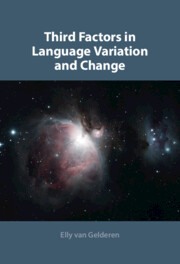Book contents
- Third Factors in Language Variation and Change
- Third Factors in Language Variation and Change
- Copyright page
- Contents
- Figures
- Tables
- Preface
- Abbreviations
- 1 The Shift towards a Minimal UG
- 2 Labeling in Language Change
- 3 Determinacy in Language Variation
- 4 Determinacy in Language Change
- 5 Labeling and Determinacy: Verb-Second and Expletives
- 6 Adjunct Incorporation and Avoiding Pair-Merge
- 7 Conclusion
- References
- Index
1 - The Shift towards a Minimal UG
Published online by Cambridge University Press: 16 December 2021
- Third Factors in Language Variation and Change
- Third Factors in Language Variation and Change
- Copyright page
- Contents
- Figures
- Tables
- Preface
- Abbreviations
- 1 The Shift towards a Minimal UG
- 2 Labeling in Language Change
- 3 Determinacy in Language Variation
- 4 Determinacy in Language Change
- 5 Labeling and Determinacy: Verb-Second and Expletives
- 6 Adjunct Incorporation and Avoiding Pair-Merge
- 7 Conclusion
- References
- Index
Summary
Chapter 1 provides some background on the shift in emphasis from Universal Grammar (UG) to third factors and gives a description of selected third factors, e.g. the Inclusiveness Condition and the Extension Condition. The main emphasis is on the Labeling Algorithm and the Principle of Determinacy. Generative models focus on the faculty of language as represented in the mind/brain. UG is the “system of principles, conditions, and rules” that all languages share through biological necessity. However, although UG received a lot of attention, recently principles “grounded in physical law” and the general “capacity to acquire knowledge” have been emphasized more. This chapter also introduces two main reasons of language change that are responsible for the linguistic cycle: those caused by economy and those by innovation.
- Type
- Chapter
- Information
- Third Factors in Language Variation and Change , pp. 1 - 28Publisher: Cambridge University PressPrint publication year: 2021

